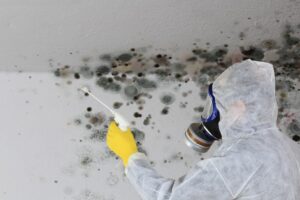If you suspect your home or business has mold, call On Call for immediate action. Mold can spread throughout a property in as little as 72 hours and can produce allergens that have the potential to cause greater health effects. Mold can also compromise the integrity of a structure, making it weaker than it should be.
Our professionals will inspect, assess, and calculate the extent of the contamination. If mold is present, we have the equipment and expertise to eliminate the mold and also remedy the source of the unwanted moisture so the mold doesn't grow again.

When Is Mold Ok?
Invasive mold growth can start in as little as 24 hours when water is present where it isn't welcome. Understanding what mold is and when it is OK can be important when deciding what action to take. Consider the following mold facts:
- Mold and fungal spores occur naturally both indoors and outdoors.
- Mold spores need moisture to grow- so areas where there is water damage, elevated humidity levels, or dampness can cause the mold to grow rapidly.
- Mold spores are microscopic and float through the air so you can often detect mold by testing the air in the effected area.
- Mold typically produces a strong, musty odor and can lead to negative health effects since it is an allergen and irritant.
- Before remediation can begin, the source that caused the mold must be addressed. Remove the source of moisture, remove the mold.
- Elevated indoor humidity levels can support mold growth so it's best to keep your home or business below 45%.
Common Causes of Mold
Mold found outdoors isn't as much of a concern since it is the earth's most important recycler, but indoor mold can cause major health problems so you'll want to pay special attention to your property if you experience any of the following:
- Flooding from surface waters or from severe storms
- Roof leaks from damaged or missing roofing materials
- Storm-driven rain through window frames, exterior walls, or doors
- Leaking pipes, sewer back-ups or overflows
- Damp basements or crawl spaces
- Condensation on cold surfaces (i.e. window frames or ledges)
Mold Removal Versus Mold Remediation
Understanding the difference between mold removal and mold remediation is important since it commonly gets confused. Since mold needs moisture to grow, first the source of the moisture needs to be addressed secondly, the mold contamination needs to be removed so it doesn't continue to spread. It's impossible to remove mold entirely since it occurs naturally both indoors and outdoors, however when it infests a home or business, there are steps that need to be taken in order to restore the property back to safe living conditions again.
Mold Removal & Remediation Process
No matter how large the mold infestation is, we follow the same steps every time in order to successfully remedy the problem:
- Safety is #1- we use the proper equipment and gear to protect all of our field workers and crew.
- Assessment and Calculation- we investigate the source of the moisture that is causing the mold and calculate the extent of the infestation.
- Contamination Control- prevent cross-contamination and the spread of mold.
- Mold Removal- physically remove the mold from the contaminated areas.
- Moisture Remediation- Eliminate and remedy the moisture problem that caused the mold outbreak.
